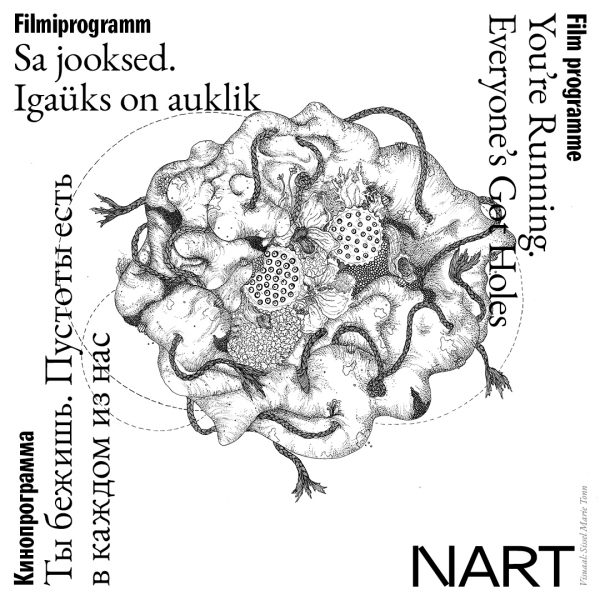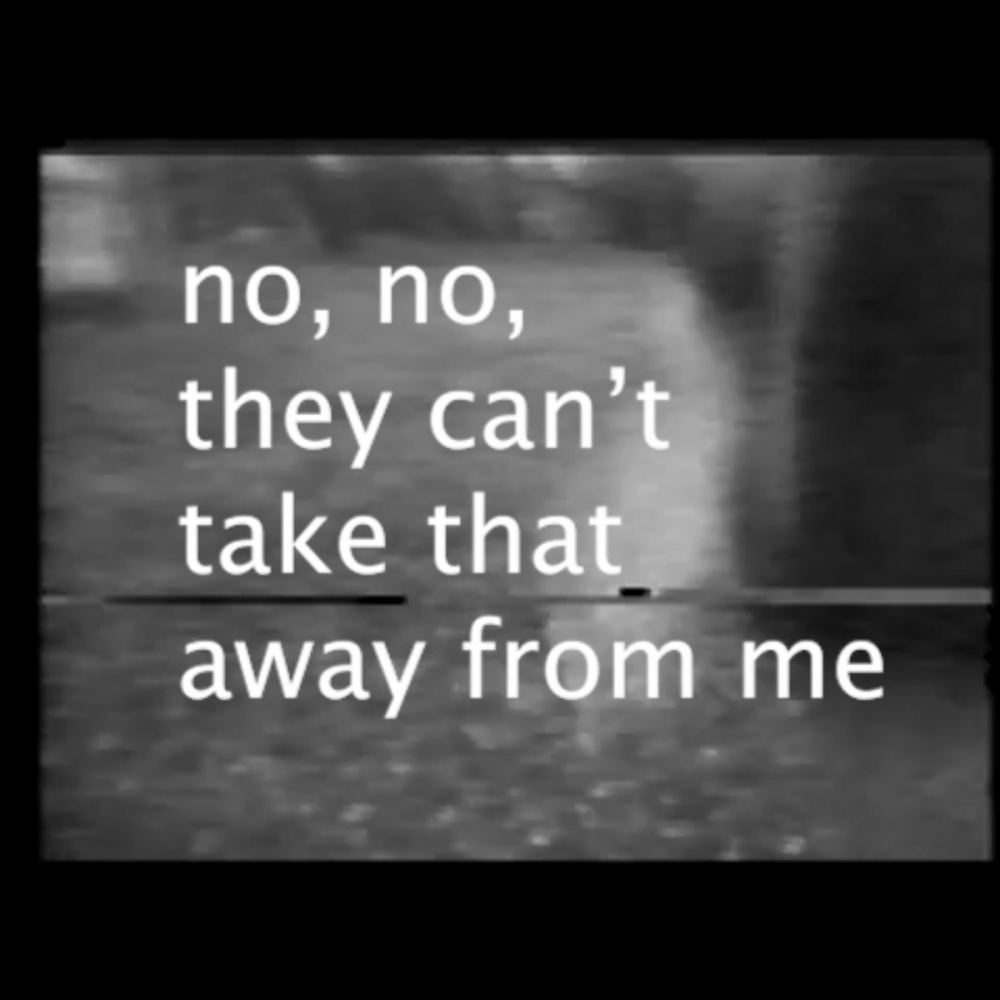
Film programme You’re Running. Everyone’s Got Holes
Curator: Piibe Kolka
The film programme accompanies the exhibition Point of No Return. Attunement of Attention, more information HERE. Download the catalogue HERE.
Screening 2 (read about Screening 1 HERE)
June 20, 2021, at 17:00
NART, 2nd floor cinema hall
Joala 18, Narva
N.B. Due to Covid-restrictions we kindly ask you to register your attendance by filling out THIS FORM.
The screening brings together five short films about everyday fluctuations – rhythms of working, sensing, transforming and enduring.

Laura Cemin
4 minutes
HD video
No dialogue
4 minute warm up is a short instructional video. The character, alone in a beautiful and spacious apartment, performs a routine created as a solution to deal with fake intimacies and loneliness, characteristics of individualistic societies. A large number of tools (such as thermal blankets and sweat belts) made to generate heat and to be used in close contact with the body, here alter their original purpose, becoming substitutes for another body. The determination in the actions in Cemin’s video feel soothing and alarming at the same time, like the constant everyday negotiation of the lonely.
Laura Cemin is an Italian artist currently based in Helsinki. She holds an MFA from Umeå Academy of Fine Arts (Sweden) and a degree in Dance. She has performed in numerous international festivals, such as Performing Love in Kiasma (Helsinki – Finland), Rum for Performance in Bildmuseet (Umeå – Sweden) and 13festivalen in Galleri Konstepidemin (Gotheborg – Sweden). Her work as a visual artist has been presented in several countries such as Italy, Estonia, Finland, Sweden, Germany and Czech Republic. She is currently part of the group exhibition Modern love (or love on the age of cold intimacies) curated by Katerina Gregos in Museum fur Neue Kunste (Freiburg – Germany) and Tallinn Art Hall (Tallinn – Estonia).

Zheng Yuan
10 minutes
4K video
In Mandarin, with Estonian, Russian and English subtitles
An exhausted motorcycle courier falls asleep on the bench of a roadside park. In the dream that takes the form of a slowly evolving long take, labourers gather together in a Shanzhai park in the desert where dynamic couriers become static “statues”. The scene stands in contrast with the speed and efficiency with which they pursue their work around the clock, revealing another side of the Chinese economic miracle: in an increasingly homogeneous urban life infused with technology and wealth, new kinds of labour and social exploitation surface. In a world of speed without rest, sleep has become a costly risk for these mobile people.
Zheng Yuan currently lives and works in Beijing. Working primarily with time-based media, his work often operates at the intersection of fiction, documentary, and essay, focusing on identity and evaluation and its ever-shifting relationship with history, power, and representation. His films are screened at film festivals including Visions du Réel, the International Short Film Festival Oberhausen, Kassel Dokfest, Ann Arbor Film Festival. He also participated in the exhibition including A Long Hello, UCCA, Beijing, 2020; everything you’ve ever wanted is on the other side of the planet, Angewandte Innovation Lab, Vienna, 2020, and others. He graduated from the School of the Art Institute of Chicago in 2015. In 2020 He won the Grand Prize of the Eighth Huayu Youth Award.

Hira Nabi
30 minutes
HD video
In Urdu, with Estonian, Russian and English subtitles
Ocean Master, a decommissioned container vessel, enters into a dialogue with several workers at the Gadani yards. The conversation moves between dreams, desires, places that can be called home, and the violence embedded in the act of dismantling a ship at Gadani. As the workers recall the homes and families they left behind, the long work days mesh indistinguishably into one another, and they are forced to confront the realities of their work in which they are faced with death every day. How may they survive and look towards the future? Hira Nabi’s film combines poignant observations with visual and conceptual poetics that make the Gadani yards and all its characters, regardless of their ontological standing, come alive.
Hira Nabi is an artist and filmmaker who works with images and text to tell stories of the everyday. Her practice is concerned with meditations on the environment, the often unseen, and a slow process of re-earthing: by which she intends to shift focus away from anthropocentric stories into a more interconnected and larger witnessing of the times we live in. Her work is built upon different forms of archival and ethnographic research as well as rituals of daily life, and tracing the impacts of modernity as felt by a ruptured society. She lives and works in Lahore, Pakistan.

Sky Hopinka
11 minutes
HD video
In English, with Estonian and Russian subtitles
Told through recollections of youth, learning, lore, and departure, this is an imagined myth for the Xąwįska, or the Indian Pipe Plant – used by the Ho-Chunk to revive those who have fainted. Through rhythms of sound, images and text, Xąwįska feels more like an old friend or a familiar smell, tied to memories, than a botanical object of study.
Sky Hopinka is a Ho-Chunk Nation national and descendent of the Pechanga Band of Luiseño Indians. He was born and raised in Ferndale, Washington, and spent a number of years in Palm Springs and Riverside, California, Portland, Oregon, and Milwaukee, Wisconsin. In Portland he studied and taught Chinuk Wawa, a language indigenous to the Lower Columbia River Basin. Working as a filmmaker, teacher, curator and artist, his practice centres around personal positions of homeland and landscape, designs of language and the facets of culture contained within. He received his BA from Portland State University in Liberal Arts and his MFA in Film, Video, Animation, and New Genres from the University of Wisconsin-Milwaukee, and currently teaches at Bard College in Film and Electronic Arts. His work has played at various festivals including ImagineNATIVE Media + Arts Festival, Images Festival, Courtisane Festival, Ann Arbor Film Festival, American Indian Film Festival, Sundance Film Festival, Antimatter Film Festival, Chicago Underground Film Festival, FLEXfest, and the LA Film Festival.

Nathaniel Dorsky
12 minutes
16mm film, color, silent, silent speed
“An aubade is a poem or morning song evoking the first rays of the sun at daybreak. Often, it includes the atmosphere of lovers parting. This film is my first venture into shooting in color negative after having spent a lifetime shooting Kodachrome. In some sense, it is a new beginning for me.” (Nathaniel Dorsky)
Nathaniel Dorsky is an experimental filmmaker and film editor who has been making films since 1963. He has resided in San Francisco since 1971. He has been making exclusively analogue works that are mostly silent and not digitised. His 16mm films are projected at so called “silent speed” – 18 frames per second.
“In a field often dominated by frenetic cutting and/or prolonged stasis, Dorsky’s films unfurl gradually but steadily in a kind of hushed suspension.” (Max Nelson)
The artist film programme accompanying NART’s annual exhibition 2021 Point of No Return. Attunement of Attention consists of two screenings taking place on two weekends in June.
The films are close to bodies, expressing rhythms and frequencies at different intersections of being. There are bodies that look for a place in physical space and landscapes, in ecological networks and economic hierarchies, bodies that move in time, bodies that perform measured gestures and find a rhythm in relationships to others. Everyone in a moment captured into an audiovisual artefact where a global connection with many others is inevitably clear, but there is only one sole body for reacting, taking a step, turning around or standing still.
The films look at at speed, efficiency and dream spaces among motorcycle couriers, instruct in gestures of fake intimacy, invite a decommissioned container vessel into a dialogue with workers dismantling it, imagine the myth of Xąwįska – a plant that revives those who have fainted, talk about borders, both inside and outside, asking if a film can be like a nest.
There’s a concreteness and determination in many of the filmic gestures, while they also echo vibrations from given or chosen contexts. Because
”[E]veryone’s got holes.[…] No amount of disintegration or porousness makes us any less human. One can remain human while being mixed up – because to be human is to be mixed up.”[1]
Supported by: British Council in Estonia, Estonian Film Institute, NomadIT.
Piibe Kolka (b. 1986) is a filmmaker, filmworker and artist who is interested in the divergent potential of film as a relatively young medium and its crossovers with other art forms. She is drawn by artist moving image as a personal practice with ample room for experimentation and inquiry into the audiovisual, temporal and rhythmic peculiarities of the genre. By alternating between questions of “what is happening?” and “how does it feel?” she explores the intensities of presence in films. Kolka has previously worked in New York as a cinematographer and editor of documentaries, narrative features and artist films. She is currently working on the Tütarrakk short film and expanded cinema project, studying the multiple interpretations of gestures performed for a camera, and delights in footage recorded on audio cassettes by a low-resolution camcorder – a pixelated, fluttering change of pace to the abundance of extremely high-definition playbacks. Kolka studied anthropology at Tallinn University (BA 2010, MA 2015) and documentary filmmaking and film studies at the New School in New York (MA 2014).
[1] E. Wilk, “This Compost: Erotics of Rot,” Granta, 7 July 2020, online publication. https://granta.com/erotics-of-rot/.

